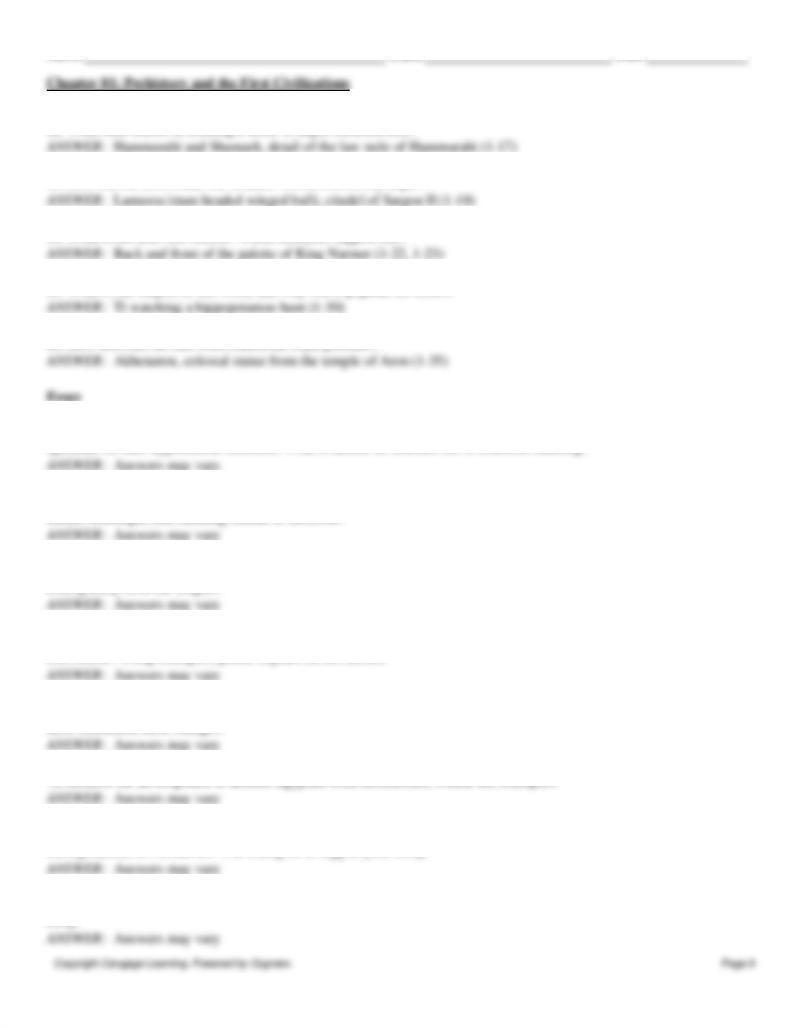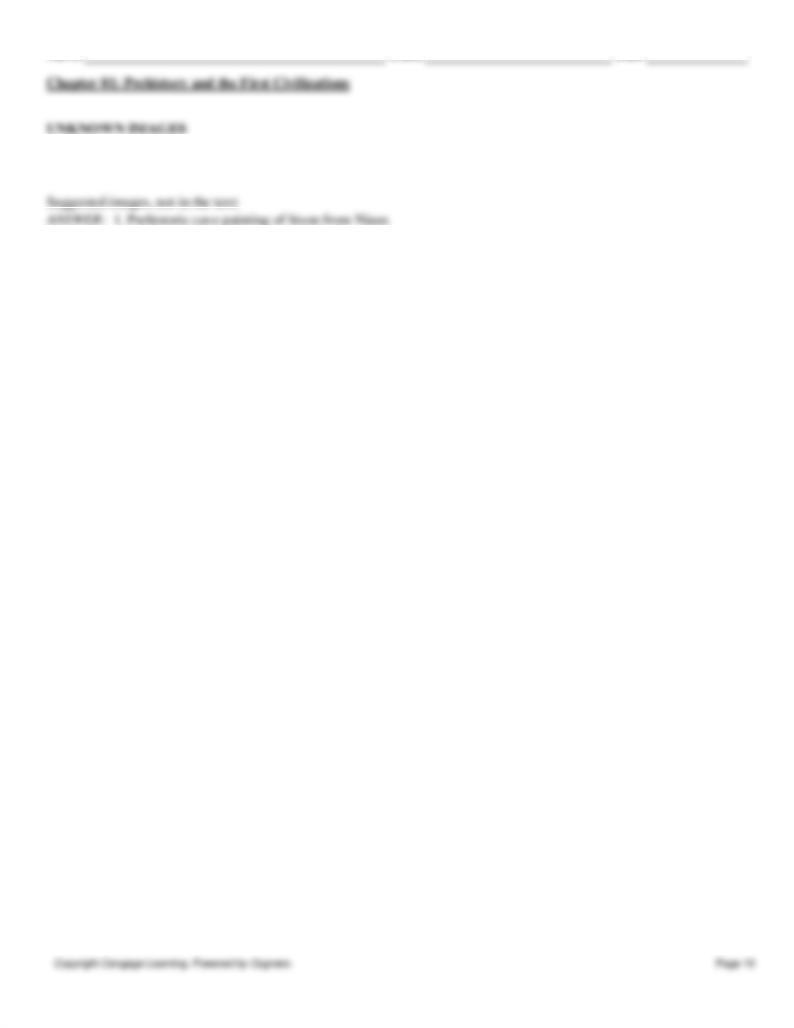
Name:
Class:
Date:
Chapter 01: Prehistory and the First Civilizations
Multiple Choice
1. The inhabitants of ancient _____ established the earliest city-states.
a.
Sumer
b.
Hattusha
c.
Persepolis
d.
Jericho
2. Sumerian artists were the first to use art to _____.
a.
capture the spirit of animals
b.
tell stories
c.
communicate with deities
d.
decorate their temples
3. The presentation of offerings to Inanna (Warka Vase) may represent a _____.
a.
victorious battle
b.
human sacrifice
c.
symbolic marriage
d.
deity ascending to the heavens
4. The earliest preserved art objects date to the _____.
a.
Assyrians
b.
Neolithic period
c.
Egyptians
d.
Paleolithic period
5. _____ is used to indicate the greater importance of figures.
a.
Hierarchy of scale
b.
Composite view
c.
Twisted perspective
d.
Bas-relief
6. The most common subject in Paleolithic art was _____.
a.
settlements
b.
animals
c.
human figures
d.
battle scenes

Name:
Class:
Date:
7. The Neolithic architecture in northern Europe is described as _____ because it uses large stones.
a.
corbeled
b.
wattle and daub
c.
megalithic
d.
henge
8. _____ was an important Neolithic settlement because it was built according to a predetermined scheme.
a.
Kalhu
b.
White Temple
c.
Stonehenge
d.
Catal Höyük
9. An arrangement of stones in a circle is called a _____.
a.
henge
b.
menir
c.
heel stone
d.
dolmen
10. The _____ introduced a new concept of royal power based on loyalty to the king.
a.
Sumerians
b.
Akkadians
c.
Guians
d.
rulers of Ur
11. The oldest extant hollow-cast sculpture is _____.
a.
two bison
b.
Hammurabi and Shamash
c.
the head of an Akkadian ruler
d.
Gudea
12. What indicates Naram-Sin’s divinity in the victory stele of Naram-Sin?
a.
Bowing warriors
b.
Royal robes
c.
Hierarchy of scale
d.
Horned helmet
13. What was the daring innovation introduced in the victory stele of Naram-Sin?
a.
A landscape setting

Name:
Class:
Date:
Chapter 01: Prehistory and the First Civilizations
b.
Registers
c.
The king’s love affair
d.
Brilliant coloring
14. _____ were colossal monsters that guarded the gates of Assyrian palaces?
a.
Warkas
b.
Lamassus
c.
Kalhus
d.
Sphinxes
15. The _____ was the Persian royal audience hall at Persepolis.
a.
hypostyle hall
b.
citadel
c.
apadana
d.
mastaba
16. _____ is the earliest extant labeled work of historical art.
a.
Assyrian archers pursuing enemies
b.
The victory stele of Naram-Sin
c.
Khafre enthroned
d.
The palette of King Narmer
17. The standard tomb type in Egypt was the _____.
a.
mastaba
b.
ziggurat
c.
pylon
d.
henge
18. Egyptians believed that their _____ could inhabit their corpse and live on.
a.
aton
b.
ka
c.
sphinx
d.
lamassu
19. Inspired by the cult of Re, the pyramidal shape of the tombs at Gizeh symbolize _____.
a.
the Nile River
b.
papyrus stalks
c.
the rays of the sun

Name:
Class:
Date:
Chapter 01: Prehistory and the First Civilizations
d.
the human figure
20. Architect of the stepped pyramid of King Djoser, _____ is the first recorded name of an artist.
a.
Thutmose
b.
Thoth
c.
Senmut
d.
Imhotep
21. Instead of creating figures with a variety of body types, Egyptians applied a _____, or system of proportions.
a.
canon
b.
cubic
c.
ka
d.
relief
22. Found at the temple of Amen Re at Karnak, the _____ or window level was an Egyptian innovation.
a.
pylon
b.
causeway
c.
clerestory
d.
serdab
23. Twisted perspective refers to _____.
a.
the incorrect representation of space
b.
objects represented from two viewpoints
c.
uneven ground lines
d.
images created on the irregular wall surface
24. The building system seen at Stonehenge is called _____.
a.
mud-brick construction
b.
masonry
c.
arcuated
d.
post and lintel
25. Which object represents the beginning of large-scale sculpture in the ancient world?
a.
Human figure, from Ain Ghazal
b.
Statuettes of two worshippers, from the Square Temple at Eshunna
c.
Victory stele of Naram-Sin
d.
Head of an Akkadian ruler, from Nineveh

Name:
Class:
Date:
26. The stele of Hammurabi presents the ruler’s famous _____.
a.
law code
b.
victory over the Lullubi
c.
entrance into Babylon
d.
Lamassu
27. The peoples of northern Europe in the Neolithic period are known for their _____.
a.
mastabas
b.
monumental stone architecture
c.
ziggurats
d.
temples
28. (Figure 1-3)
a.
Paleolithic
b.
Neolithic
c.
Sumerian
d.
Egyptian
29. (Figure 1-2)
a.
Nude moman (Venus of Willendorf)
b.
Mother goddess
c.
Woman of Laussel
d.
Human figure
30. (Figure 1-4)
a.
Pech-Merle
b.
Lascaux
c.
Altamira
d.
Chauvet
31. (Figure 1-8)
a.
Paleolithic
b.
Neolithic
c.
Mesolithic
d.
Monolithic

Name:
Class:
Date:
32. (Figure 1-10)
a.
Sumerian
b.
Akkadian
c.
Babylonian
d.
Assyrian
33. (Figure 1-12)
a.
Deities
b.
Court of Gudea
c.
Council of Ur
d.
Votive figures
34. (Figure 1-14)
a.
Standard of Cyrus
b.
Standard of Hammurabi
c.
Standard of Ur
d.
Standard of Akhenaton
35. (Figure 1-16)
a.
Naram-Sin of Akkad
b.
Hammurabi of Babylon
c.
Gudea of Lagash
d.
Hatshepsut of Egypt
36. (Figure 1-25)
a.
Pyramid of Khafre
b.
Stepped pyramid of Djoser
c.
Mortuary temple of Hatshepsut
d.
Temple Amen-Re,Karnak
37. (Figure 1-28)
a.
Akhenaton
b.
Ramses II
c.
Hatshepsut
d.
Khafre
38. (Figure 1-29)
a.
Ti and consort

Name:
Class:
Date:
Chapter 01: Prehistory and the First Civilizations
b.
Akhenaton and Nefertiti
c.
Senmut and Hatshepsut
d.
Menkaure and Khamerernebty
39. (Figure 1-32)
a.
Gizeh
b.
Amarna
c.
Saqqara
d.
Abu Simbel
40. (Figure 1-33)
a.
Saqqara
b.
Karnak
c.
Luxor
d.
Gizeh
41. (Figure 1-35)
a.
Khafre
b.
Hatshepsut
c.
Tutankhamen
d.
Akhenaton
42. (Figure 1-34)
a.
Old Kingdom
b.
Middle Kingdom
c.
New Kingdom
d.
Late Kingdom
43. What “firsts” were achieved by the Sumerians?
44. Why were animals represented in the profile view in the Paleolithic period?
45. Describe how Paleolithic artists created cave paintings.
46. How have scholars interpreted handprints in Paleolithic cave paintings?

Name:
Class:
Date:
Chapter 01: Prehistory and the First Civilizations
47. How did painting techniques change from the Paleolithic period to the Neolithic period?
48. How did society advance in the Neolithic period?
49. Describe the significance of the temple in Sumerian life.
50. What subjects decorated the walls of the terraces and staircase that led to the apadana at Persepolis?
51. What are the main components of a mastaba?
52. Describe what inspired the pyramid shape of the pyramids at Gizeh.
53. What is the sphinx, and why is it an appropriate royal image?
54. Describe the New Kingdom pylon temple.
55. Describe the pictorial conventions that appear on this artwork and would continue to be employed in Sumerian art.
56. What was the possible meaning or function of this object?
57. What does this work tell us about what inspired early artists to create certain images?
58. How does this differ from Paleolithic cave paintings?
59. What might explain the disproportionate sizes of the hands and eyes of these figures?
60. What are the differing interpretations of the imagery on this artwork?
61. How was a balance between naturalism and abstraction achieved in this work?

Name:
Class:
Date:
62. What innovations in creating a sense of depth occurred here?
63. How did the artist make the creature visible from every angle?
64. What event does this record? Which elements support this?
65. What is the subject of this work, and why was it popular for tombs?
66. How does this deviate from traditional royal portraits?
67. With the lack of writing, it is hard to determine the exact meaning of Paleolithic artworks. Providing examples, please
speculate on their hypothetical functions. What evidence do scholars use to establish meaning?
68. Compare and contrast select artworks from the Paleolithic and the Neolithic periods. To what extent were subject
matter, technique, and meaning similar or different?
69. Describe the difference between optical and conceptual. Please provide examples of depicting a figure or animal
conceptually from the chapter.
70. What were some of the dominant artistic conventions of Ancient Near Eastern? Which artworks broke from
convention? Using examples, please explain the deviations.
71. Selecting examples, please provide the artistic changes that occurred during the reign of Akhenaton. What factors may
have stimulated these changes?
72. Discuss the development of ancient Egyptian tomb architecture. Please use examples.
73. Discuss the meaning and purpose of Assyrian historical narrative relief. How did it compare to narratives in ancient
Mesopotamian or Persian art? Use examples to support your essay.
74. Assess the relationship between Egyptian conceptions of the afterlife and Egyptian art. Use examples to support your
essay.

Name:
Class:
Date:
75. Attribute the images on the screen to a culture and give an approximate date. Explain your attributions, using complete
sentences and referring to specific works discussed in class.
2. Prehistoric Lake Trasimene woman
3. Another Assyrian battle relief
4. Another Sumerian relief such as stele of Ur-Nammu or votive tablet of Ur-Nanshe
5. Akhenaton and Nefertiti with their children (relief)